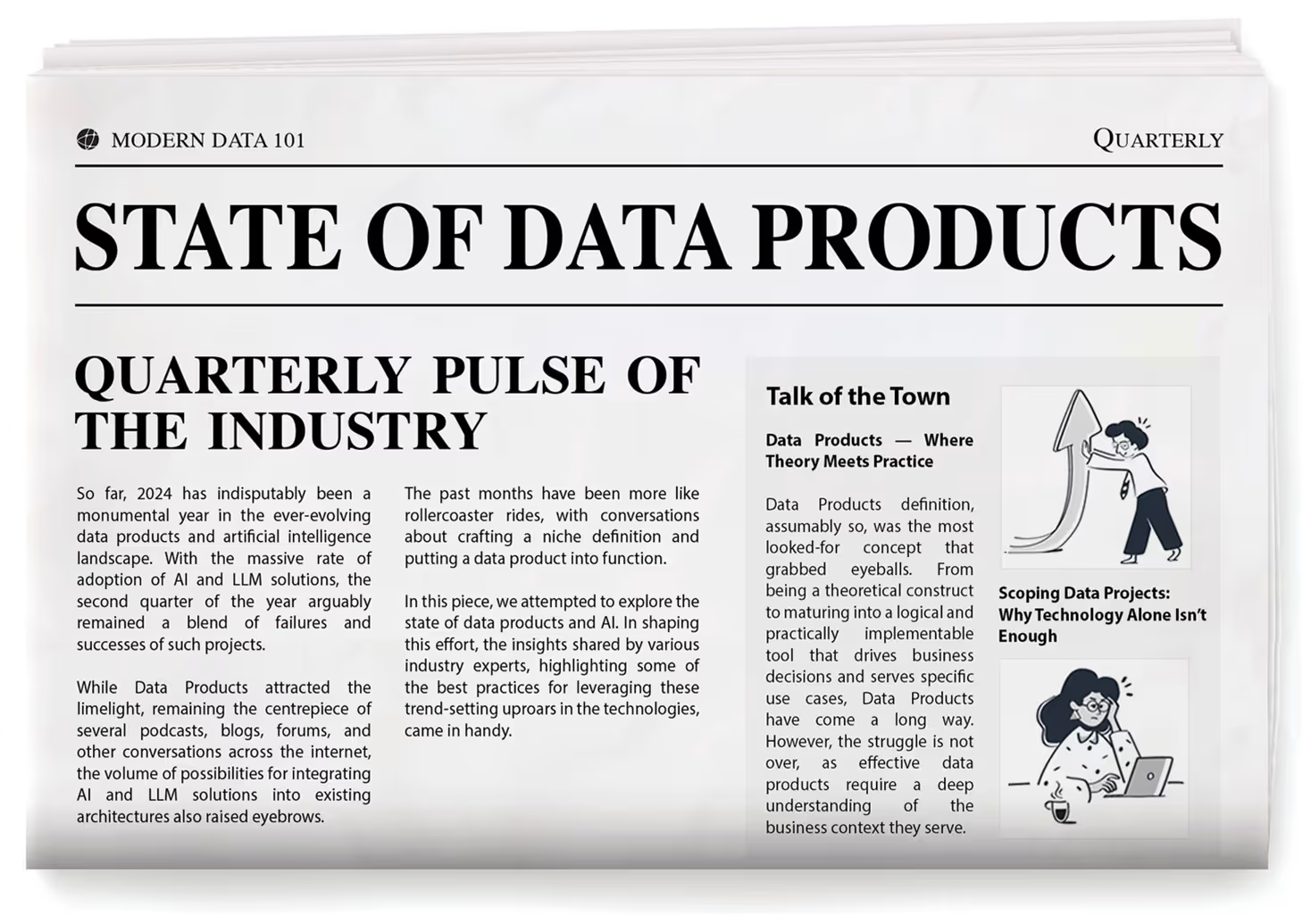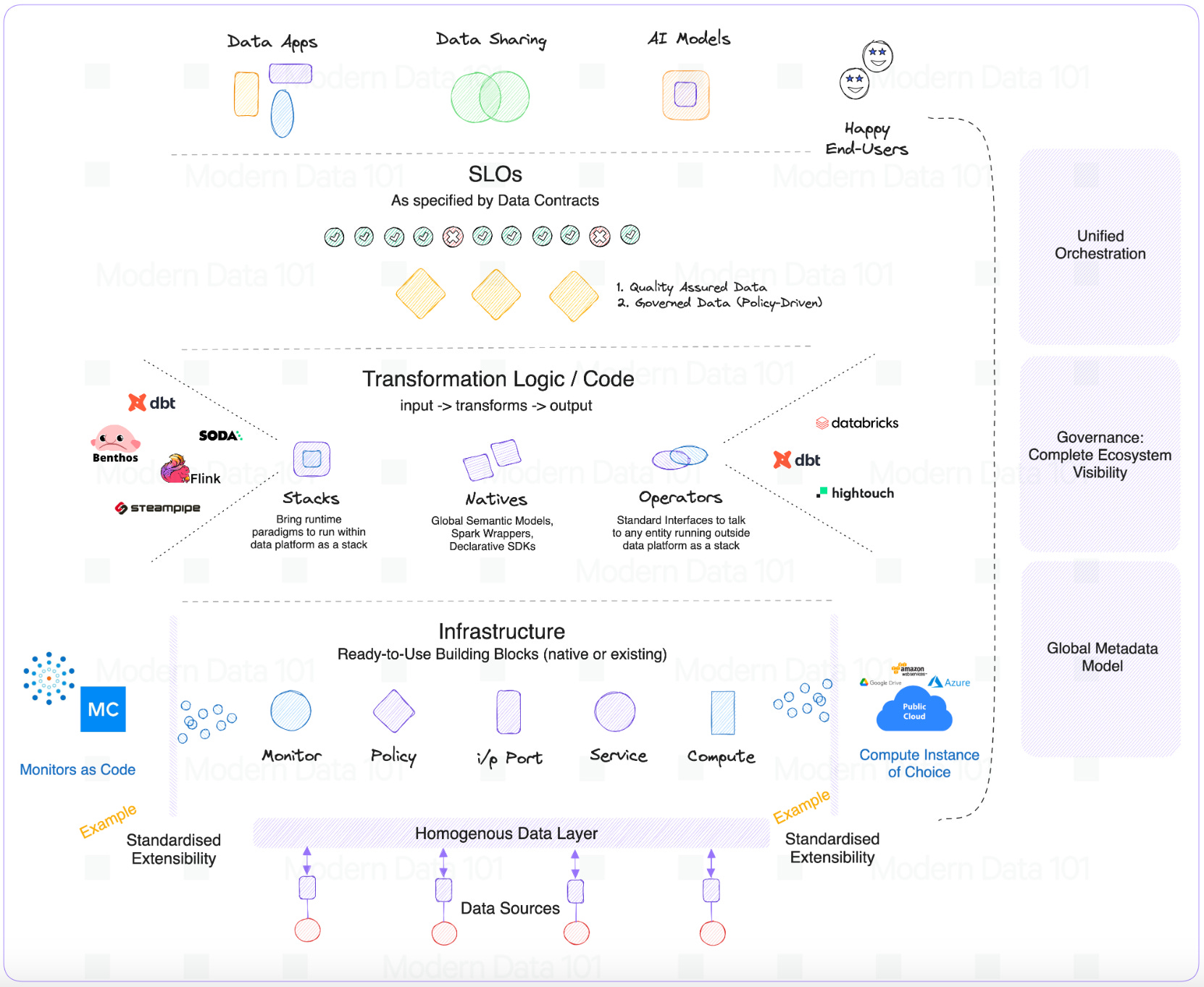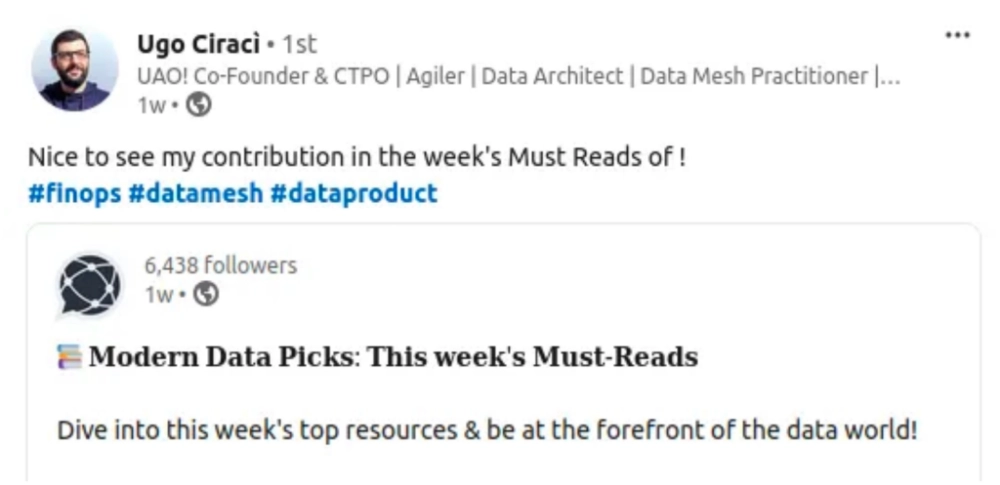
TL;DR
Editorial 🤓
While we continue to get trampled by an overhaul of innovations, strategies, and frameworks, let’s cut out the overwhelm and come down to the first principles and fundamentals of what challenges we are trying to solve.
Broadly, with data, we fall into a PPDAC cycle:

While a data product is a framework, data teams would continue to spend most of their time understanding the data. So, the key question is how easily could this be enabled? How easily can data teams understand their data, access it for analysis, and process it for downstream applications?
In one of our recent threads, we approached this from an infrastructure point of view, where we enlisted the qualities necessary for any data infrastructure that intends to support data products.
But this cannot just be addressed by a deeply embedded infrastructure layer. How do we surface the infrastructure benefits to the data teams who are actually spending hours and weeks trying to understand the data?
Muddy puddles demand some splashing around 🌊
Let’s face it. Data Products are, to some extent, still a vague construct for a large part of the community. As with all cycles, this, too, will take some time to reach peak awareness. So, when data developers, architects, and business guys are not quite high on clarity, they can easily fall into pits of significant collateral damage, especially in rigid legacy data stacks with high data debt.
Does that mean ignorance is bliss, and we should let the winds of change pass us by? Hardly. Data Product, though slightly muddy for the larger crowd, has significant tangible benefits. In fact, it’s one way to ground us against disruptive trends and innovations since it forms the fundamental building block of most data design frameworks.
The fundamentals don’t change nearly as fast as the latest tech de jour. Focus on what doesn’t change and build from there. ~ Joe Reis, Author of Fundamentals of Data Engineering
The qualities surfaced by the crisp container of Data Products have been desirable by data consumers since time immemorial and are unlikely to change shape anytime soon. Aka: Discoverable, Addressable, Understandable, Natively Accessible, Trustworthy, Interoperable, Independent, and Secure.
All work and no play makes Jack a dull Data Developer
Innovation and experimentation are at the forefront of successful data teams, which is why innovation-aligned metrics such as cost of failed experiments, total cost of ownership of experiments, time to recovery, etc., are at the focal point of high-performance teams.
Data developers need a playground to run their experiments without causing a tangible impact on the data. In other words, a “Figma for Data Products”.
Just like Figma offers us an interface to design and play around with product wireframes without actually having backend teams do the hard work until a couple of wireframes are shortlisted, a Data Lens does the same for data products.
We refer to it as a “lens” because it instantly spins up a relatable visual and largely conveys the meaning in simple lingo. A data lens is, therefore, a way to zoom into data- a view or a collection of views. In technical terms, this is a semantic modeling playground.
How does this convert into a “Figma for Data Products”?
Design multiple experimental Data Product wireframes first. Implement the backend for the top experiments later.
Right-to-Left Data Engineering or the Product Approach in Action
You define the problems first, identify gaps, metrics, and requirements, and then move on to unleash xyz technology to solve that challenge. A semantic modeling layer allows you to define not just the business logic but also the SLO requirements against every logical entity. In summary, you create the front-end design for your product.
A semantic model essentially means a logical model or a set of views from across the contributing data sources. These data views allow you to access data from various sources consistently and build your minimum viable product without having to actually move the data over expensive pipelines.

Test experiments before expensive migration and plausible data corruption
Experiment and present without any actual data movement or migration. Play around with dataviews and combinations, explore data, and run experiments countless times with insignificant load on expensive resources before finalizing your data product.
Users only materialise data when they are certain about the experiment or the logical channel. With this layer, you can simply use semantic queries in a few lines for fast trials instead of writing hundreds of lines of complex SQL joins. This implies access to relevant business objects and the ability to drill down on key performance indicators by dimensions.

Deployment of the design: One-step infrastructure spin up
Once the experiment proves to have potential and feasibility, the data consumer can choose to materialise the data from the physical sources to the output ports (channel data instead of views to their applications or output ports).
Data producers can refer to the consumer requirements defined in the semantic model to create and own data contracts for the data they produce. While the data engineering team maps the sources to the semantic models during the initial stages for facilitating data views, infrastructure resources for bearing the load of physical data movement are only provisioned when there is a demand for materialisation (provisioned as per the data load that the experiment needs to bear).}
Ideal capabilities you can leverage through a “Figma for Data Products”:
- Semantic data model & views: Entities, Relationships, Measures, Dimensions
- Explorer: Semantic queries, UI-based query generators, Graph views
- Asset-level semantics: Description, column names and description, purpose, etc.

Want to dive deeper? More on similar lines: Optimizing Data Modeling for the Data-First Stack
Community Space 🫂
We discovered a gem recently- an approach to data products way back in 2012 published on O'Reilly Radar. Instead of being hung up on how they define data products or in which context (statistics & predictive modeling), let’s focus on their successful approach to the purpose that’s relevant even today: data products that transform the raw data into an actionable outcome. We could identify similar challenges and, therefore, similar challenges they deployed to
We are entering the era of data as drivetrain, where we use data not just to generate more data (in the form of predictions), but use data to produce actionable outcomes. That is the goal of the Drivetrain Approach.
“When dealing with hundreds or thousands of individual components models to understand the behavior of the full-system, a ‘search’ has to be done. I think of this as a complicated machine (full-system) where the curtain is withdrawn and you get to model each significant part of the machine under controlled experiments and then simulate the interactions. Note here the different levels:
1. models of individual components
2. tied together in a simulation given a set of inputs
3. iterated through over different input sets in a search optimizer.”

Essentially, this approach demands a simulated playground for experimentation to reach actionable insights sooner instead of deploying resource-heavy pipelines for every experiment. In essence, when it comes to data, be it data product or not, experimentation is a fundamental non-negotiable. Naturally, when it comes to Data Products, as we know them today, the ability to experiment without any collateral damage is probably the primary objective at this stage.
Upcoming Data Events 📢
CDAO Chicago
Reconnecting Chicago's Data & Analytics Leaders In-Person to Accelerate Their Data Transformation Strategies. In this event, you’ll get an opportunity to join your data & analytics peers as you discover the latest trends and how to overcome challenges facing your role.
Speakers Include - Vijay Rajandram(CDO - Northern Trust Asset Management), Sherri Adame(Data Governance Lead - General Motors), Milad Toliyati(CDAO Director of Analytics - Cisco), Flo Castro-Wright(CDO - CDC Foundation), and many such renowned folks from modern data space. Don’t miss your chance to gain insights into the latest trends and practices. Register on the link below!
Event Date: August 8-9, 2023
Mode: Offline
Register
TDWI San Diego
A. The Leading Data and Analytics Education Conference
TDWI Conferences provide industry-leading education for business and technology professionals, offering in-depth education, networking, and exposure to the latest technology offerings.
This six-day conference is designed for data professionals and leaders to learn about different aspects of data strategies, ML, Data Science and more! Last date to register for the event is 4th August, hurry up!
Event Date: August 6—11, 2023
Mode: Offline
Register
B. TDWI Executive Summit, Analytics
Executive Summit for Analytics Co-Located with TDWI San Diego
Event Date - August 8-9, 2023
Mode: Offline
Register
Thanks for Reading 💌
As usual, here’s a light breather for you for sticking till the end!

Follow for more on LinkedIn and Twitter to get the latest updates on what's buzzing in the modern data space.
Feel free to reach out to us on this email or reply with your feedback/queries regarding modern data landscapes. Don’t hesitate to share your much-valued input!
ModernData101 has garnered a select group of Data Leaders and Practitioners among its readership. We’d love to welcome more experts in the field to share their stories here and connect with more folks building for the better. If you have a story to tell, feel free to email the Editor!



Author Connect 🖋️

Animesh Kumar

Animesh Kumar is the Co-Founder and Chief Technology Officer at The Modern Data Company, where he leads the design and development of DataOS, the company’s flagship data operating system. With over two decades in data engineering and platform development, he is also the founding curator of Modern Data 101, an independent community for data leaders and practitioners, and a contributor to the Data Developer Platform (DDP) specification, shaping how the industry approaches data products and platforms.

Modern Data 101

Animesh Kumar is the Co-Founder and Chief Technology Officer at The Modern Data Company, where he leads the design and development of DataOS, the company’s flagship data operating system. With over two decades in data engineering and platform development, he is also the founding curator of Modern Data 101, an independent community for data leaders and practitioners, and a contributor to the Data Developer Platform (DDP) specification, shaping how the industry approaches data products and platforms.

More about
Figma for Data Products: Novel tech requires enough experimentation and a big playground
Checkout our

Community resources
and

Related articles


























